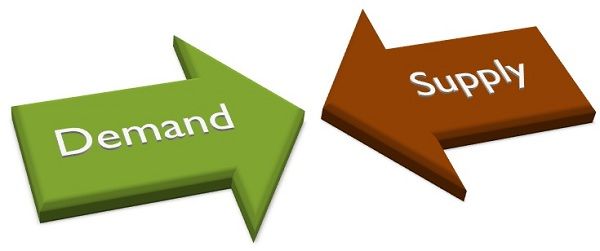 To understand the market mechanism, one needs to have a good knowledge of demand and supply, as these two forces regulate the entire market. Demand implies the desire for a good, supported by the ability and readiness to pay for it. On the other hand, supply alludes to the total amount of a commodity ready for sale.
To understand the market mechanism, one needs to have a good knowledge of demand and supply, as these two forces regulate the entire market. Demand implies the desire for a good, supported by the ability and readiness to pay for it. On the other hand, supply alludes to the total amount of a commodity ready for sale.
When demand rises there is a shortage in the supply and when a supply is enough the demand falls short, so there is an inverse relationship between these two elements.
Nowadays people are very selective regarding the things they use, carry and wear. They are very conscious about what to purchase and what not to? A little change in the prices or the availability of a commodity affects people drastically.
The demand and supply model is helpful in simplifying how the price and quantity traded are ascertained in the market as well as how the outside forces affect the demand and supply of the commodity. Go through with this write-up to get a clear understanding of the difference between demand and supply.
What is a Market?
Any arrangement wherein two parties, i.e. a buyer and seller are brought together to enter into an exchange of goods and services for money.
Also Read: Difference Between Industry and Market
Content: Demand Vs Supply
Comparison Chart
Definition of Demand
Demand is the customer’s desire for a particular product, at the given price, which he/she is ready to buy in one market at different prices during a given period of time. So, there are two aspects of demand:
- Willingness to buy: It is the customer’s desire for the good.
- Ability to pay: It is the customer’s purchasing power to pay the price for the goods.
The demand of the customers depend on their needs and wants. Further, to constitute an effective demand, there must be
- A desire
- Means to purchase and
- Willingness to use those means for the purchase.
For example, A beggarman also has a desire for food and clothes, but he does not have the money to buy them, so it does not amount to an effective demand.
Law of Demand
When there is a rise in the price of the product, the customers demand less quantity, whereas when the prices fall, the demand for the product will rise.
Here, you can see in the graph, wherein the vertical axis represents the price of a commodity, and the horizontal axis indicates the quantity demanded. The demand curve is an indicator of the inverse relationship between price and quantity demand.
Also Read: Difference Between Demand and Quantity Demanded
Definition of Supply
Supply implies the quantity (how much) of a product or service which are offered by the manufacturer for sale at various prices to the customers, during a given period of time. So, there are two determinants of supply:
- Willingness: The quantity of the product which the producers want or are prepared to sell at various prices.
- Ability to supply: How much of a product is available with the producers to sell at a time.
It should be noted that supply is anything that the firm has offered for sale in the market.
Law of Supply
When there is an increase in the price of the commodity, the quantity of the products produced and available for sale will also increase, and when the prices drop, the supply also decreases. this is due to the fact that the higher the price, the higher will be the profit margin.
Here in the graph, the vertical axis represents the price of a commodity, and the horizontal axis indicates the quantity supplied. Supply curve represents a direct relationship between price and quantity supplied.
Key Differences Between Demand and Supply
Upcoming points will explain to you the difference between demand and supply:
- Demand is the willingness and paying capacity of a buyer at a specific price. On the other hand, Supply is the quantity offered by the producers to its customers at a specific price.
- While the demand curve is downward to the right, the supply curve is upward to the right. And so the demand curve is a negative slope whereas the supply curve is a positive slope.
- Demand has an indirect relationship with the price i.e. as the price increases, quantity demanded decreases and vice versa. Conversely, the supply has a direct relationship with price in the sense that when the price increases, quantity supplied increases and vice versa
- While demand is an indicator of customers or buyers, supply represents the firm or producers of the product.
- Demand for a product is influenced by five factors – Taste and Preference, Number of Consumers, Price of Related Goods, Income, Consumer Expectations. In contrast, Supply for the product is dependent on Price of the Resources and other inputs, Number of Producers, Technology, Taxes and Subsidies, Consumer Expectations.
- When the demand increases but supply remains constant, it leads to shortage but when the demand decreases and the supply is constant leads to surplus. As against, when the supply increases but demand remains constant, it leads to surplus but when the supply decreases and the demand is constant it results in shortage.
Video: Demand Vs Supply
Determinants of Demand
The demand for a good or service is determined by the given factors: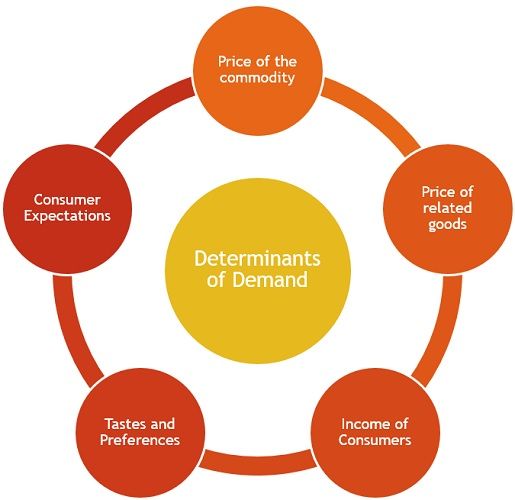
- Price of the commodity: We know that demand and price, hold an inverse relationship, so whenever, the price of the commodity shoots up, the quantity demanded experiences a drop.
- Price of related goods: Related goods can be of two types:
- Complementary goods: Goods which are consumed together are called complementary goods, such as shoes and socks, wire and plug, ink pad and stamp. A rise in the price of one will result in the demand of the other to fall.
- Competing goods or substitutes: Goods which are consumed to satisfy the same want are counted as substitutes for one another, such as bulb and tube light, soap and body wash, shoes and slipper, etc. In the case of substitute products, a rise in the prices of a product leads to the rise in demand for its substitutes.
- Income of Consumers: The purchasing power of a consumer depends primarily on his income. Therefore, the higher the income of the consumer, the higher will be the quantity demanded.
- Tastes and Preferences: Consumer tastes and preferences change over time and it has been observed that trending items often fetch high demand, as compared to the outdated one.
For example: During the lockdown period, a rise in the demand for laptops has been recorded, because work from home is given by many companies. - Consumer Expectations: When there is an expectation of rise or fall in prices or any sudden change in the economy, it affects the current demand for the product.
For instance: You might have noticed that the demand for the groceries and essential items increased prior to the lockdown became effective countrywide.
Determinants of Supply
The supply of the good or service is determined by the following factors: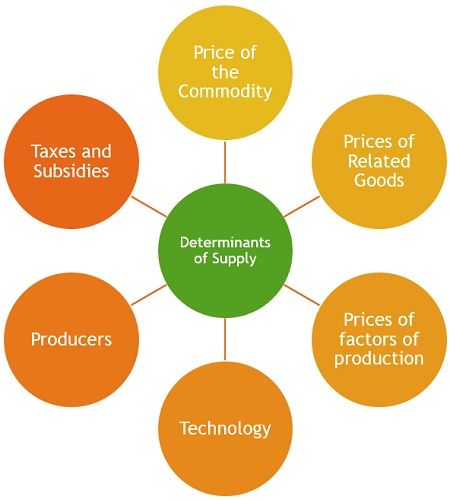
- Price of the Commodity: The higher the price of the commodity, the higher will be its quantity supplied. This is due to the fact that the firm produces goods and services with an aim of earning profits and when the price increases, the profit margin of the firm also tends to rise.
- Prices of Related Goods: When there is a hike in prices of the related goods, then obviously, it is a profitable option for the firm to produce and sell the related goods, then the good in question, and this will lead to the fall in in the quantity supplied of that commodity.
For example: If there is a rise in the price of pulses, the farmers will use their resources to grow pulses, rather than other cereals, as it is a more profitable option to them. - Prices of factors of production: The cost of production depends on the factors of production, which influences the supply of the product. A hike in the price of input will automatically increase the cost of production and affects its profitability.
For example: Suppose the prices of petrol shoot up, which leads to an increase in the cost of production as well as transportation of the goods. - Technology: Technology has a great impact on production, as new and improved methods are developed, which are better in terms of productivity and quality of the goods while using the same amount of resources. So, this results in the increase in quantity supplied of some products, while decreasing the quantity supplied of another which are displaced.
- Producers: If there are many firms in the market producing the same product, then obviously the supply will be more.
- Taxes and Subsidies: Government imposes taxes on the production of goods and a rise in the rate of taxes will lead to a rise in the cost of production. Therefore, only when there is a rise in its prices, the quantity supplied will be increased. Contrary to this, Government subsidies, often bring down the cost of production, so the firms can easily increase supply.
Equilibrium Point
The equilibrium point is a situation in which the quantity demanded and quantity supplied intersect, representing equilibrium price. It is the point at which the buyers and sellers, both are satisfied. Also called as the market equilibrium or market-clearing price.
Let’s have a look at the example:
| Price | Quantity Demanded | Quantity Supplied |
|---|---|---|
| 10 | 10 | 50 |
| 8 | 20 | 40 |
| 6 | 30 | 30 |
| 4 | 40 | 20 |
| 2 | 50 | 10 |
Have a look at the graph representing the demand and supply for the commodity at different price range:
Here you can see that at point ‘E’ both demand and supply curve intersect each other.
The equilibrium in the quantity demanded and supplied will help the firm to stabilize and survive in the market for a longer duration while the disequilibrium in these will have severe effects on the firm, markets, other products and the whole economy will suffer as a whole.
Conclusion
The market is flooded with several substitutes in each product category and a sudden rise or fall in the prices will have an impact on these products and their demand and supply may increase or decrease. In such a situation, an equilibrium must be maintained in the quantity demanded and the quantity supplied without neglecting the price factor at which the product is supplied.
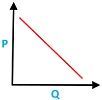
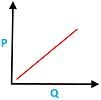

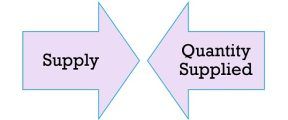
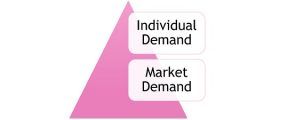
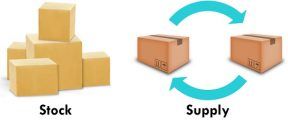



prashanth says
Great article, good job
maggie griffin says
this has helped a lot for my notes for school it is so amazing I would prefer this to everyone in in my class
Sarah says
It’s so nice
Comfort omowumi says
This has helped in writing my assignment.mine was the best.this is a very nice article
Minhal says
Awesome amazing
Paul Chinonso says
I like the website, and they are so reliable
Rahama Iddrisu says
It’s understandable
Anyaegbu Mainah Mike says
I love the website a lot. And it also helped me with my assignment . Nice article.
Uchechi Onyeike Racheal says
This articles was really helpful 🙏🙏 i really feel good at the end of writing what i wanted for as an assistant. Thanks dear author
Tortaa Fedelix says
The platform helped me understand demand and supply vividly. Thank you
Festus taiwo says
Very educative
Kirubel says
I love the article and it helped me with my economics assignment. Thank you, for whoever organized it.